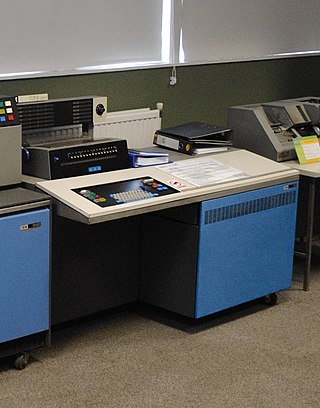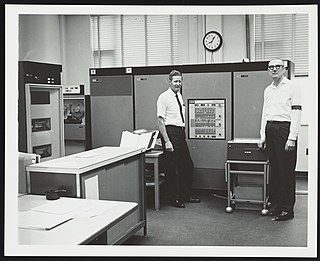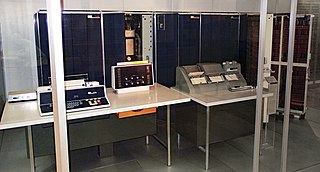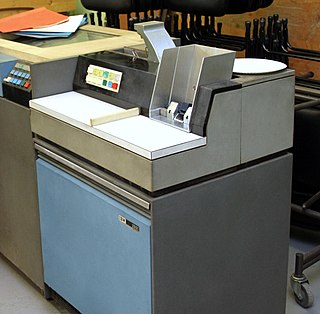Related Research Articles

The IBM 3270 is a family of block oriented display and printer computer terminals introduced by IBM in 1971 and normally used to communicate with IBM mainframes. The 3270 was the successor to the IBM 2260 display terminal. Due to the text color on the original models, these terminals are informally known as green screen terminals. Unlike a character-oriented terminal, the 3270 minimizes the number of I/O interrupts required by transferring large blocks of data known as data streams, and uses a high speed proprietary communications interface, using coaxial cable.

IBM 1442 is a combination IBM card reader and card punch. It reads and punches 80-column IBM-format punched cards and is used on the IBM 1440, the IBM 1130, the IBM 1800 and System/360 and is an option on the IBM System/3.

The IBM 1440 computer was announced by IBM October 11, 1962. This member of the IBM 1400 series was described many years later as "essentially a lower-cost version of the 1401", and programs for the 1440 could easily be adapted to run on the IBM 1401.

The IBM 1130 Computing System, introduced in 1965, was IBM's least expensive computer at that time. A binary 16-bit machine, it was marketed to price-sensitive, computing-intensive technical markets, like education and engineering, succeeding the decimal IBM 1620 in that market segment. Typical installations included a 1 megabyte disk drive that stored the operating system, compilers and object programs, with program source generated and maintained on punched cards. Fortran was the most common programming language used, but several others, including APL, were available.

The IBM 1800 Data Acquisition and Control System (DACS) was a process control variant of the IBM 1130 with two extra instructions, extra I/O capabilities, 'selector channel like' cycle-stealing capability and three hardware index registers.

The IBM System/3 was an IBM midrange computer introduced in 1969, and marketed until 1985. It was produced by IBM Rochester in Minnesota as a low-end business computer aimed at smaller organizations that still used IBM 1400 series computers or unit record equipment. The first member of what IBM refers to as their "midrange" line, it also introduced the RPG II programming language. It is the first ancestor in the product line whose current version is the IBM i series and includes the highly successful AS/400.
In computer hardware, a controller may refer to:
Remote job entry, or Remote Batch, is the procedure for sending requests for non-interactive data processing tasks (jobs) to mainframe computers from remote workstations, and by extension the process of receiving the output from such jobs at a remote workstation.

IBM 7070 is a decimal-architecture intermediate data-processing system that was introduced by IBM in 1958. It was part of the IBM 700/7000 series, and was based on discrete transistors rather than the vacuum tubes of the 1950s. It was the company's first transistorized stored-program computer.
A computer operator is a role in IT which oversees the running of computer systems, ensuring that the machines, and computers are running properly. The job of a computer operator as defined by the United States Bureau of Labor Statistics is to "monitor and control ... and respond to ... enter commands ... set controls on computer and peripheral devices. This Excludes Data Entry."

The IBM 2540 is a punched-card computer peripheral manufactured by IBM Corporation for use of System/360 and later computer systems. The 2540 was designed by IBM's Data Processing Division in Rochester, Minnesota, and was introduced in 1965. The 2540 can read punched-cards at 1000 cards per minute (CPM) and punch at 300 CPM. The 2540 is based on the design of the older, slightly slower, 1402.
The IBM 2780 and the IBM 3780 are devices developed by IBM for performing remote job entry (RJE) and other batch functions over telephone lines; they communicate with the mainframe via Binary Synchronous Communications and replaced older terminals using synchronous transmit-receive (STR). In addition, IBM has developed workstation programs for the 1130, 360/20, 2922, System/360 other than 360/20, System/370 and System/3.

IBM 1050 Data Communications System is a computer terminal subsystem to send data to and receive data from another 1050 subsystem or IBM computer in the IBM 1400, IBM 7000 or System/360 series. It first became available in 1963 and was used widely during the 1960s. The 1052 Printer-Keyboard was also the basis for the 1052-7 console Printer-Keyboard used on small and medium S/360 processors.

A computer punched card reader or just computer card reader is a computer input device used to read computer programs in either source or executable form and data from punched cards. A computer card punch is a computer output device that punches holes in cards. Sometimes computer punch card readers were combined with computer card punches and, later, other devices to form multifunction machines.
The IBM 2790 Data Communications System is a family of devices intended for "in-plant data communications and production monitoring." It is described as a two-way data communications system designed to accommodate large volumes of short messages from many in-plant locations or from smaller groups of terminals at remote locations.

270x is a generic name for a family of IBM non-programmable communications controllers used with System/360 and System/370 computers.

The IBM System/360 Model 20 is the smallest member of the IBM System/360 family announced in November 1964. The Model 20 supports only a subset of the System/360 instruction set, with binary numbers limited to 16 bits and no floating point. In later years it would have been classified as a 16-bit minicomputer rather than a mainframe, but the term "minicomputer" was not current, and in any case IBM wanted to emphasize the compatibility of the Model 20 rather than its differences from the rest of the System/360 line. It does, however, have the full System/360 decimal instruction set, that allows for addition, subtraction, product, and dividend of up to 31 decimal digits.

The IBM 2501 is a punched-card reader from IBM with models for the System/360 and System/370 mainframe systems and for the IBM System/360 Model 20, the IBM 1130 and IBM System/3 minicomputers. 2501 models can read 80-column cards at either 600 or 1000 cards per minute (CPM).

The IBM System/360 Model 25 is a low-end member of the IBM System/360 family. It was announced on January 3, 1968, 3 years before the IBM System/360 Model 22, as a "bridge between its old and new computing systems".
References
- ↑ IBM Corporation. "DPD Chronology 1972". IBM Archives. Archived from the original on October 23, 2009. Retrieved February 12, 2013.
- ↑ IBM Corporation (1972). IBM 2922 Programmable Terminal RPQ 810563, 810564, 810565 Component Description (PDF).
- ↑ IBM Corporation (1974). IBM System/360 and System/370 Bibliography (PDF).
- ↑ "Centralization Saves $500,000 Annually for Miss". Computerworld. July 17, 1974. Retrieved February 12, 2013.